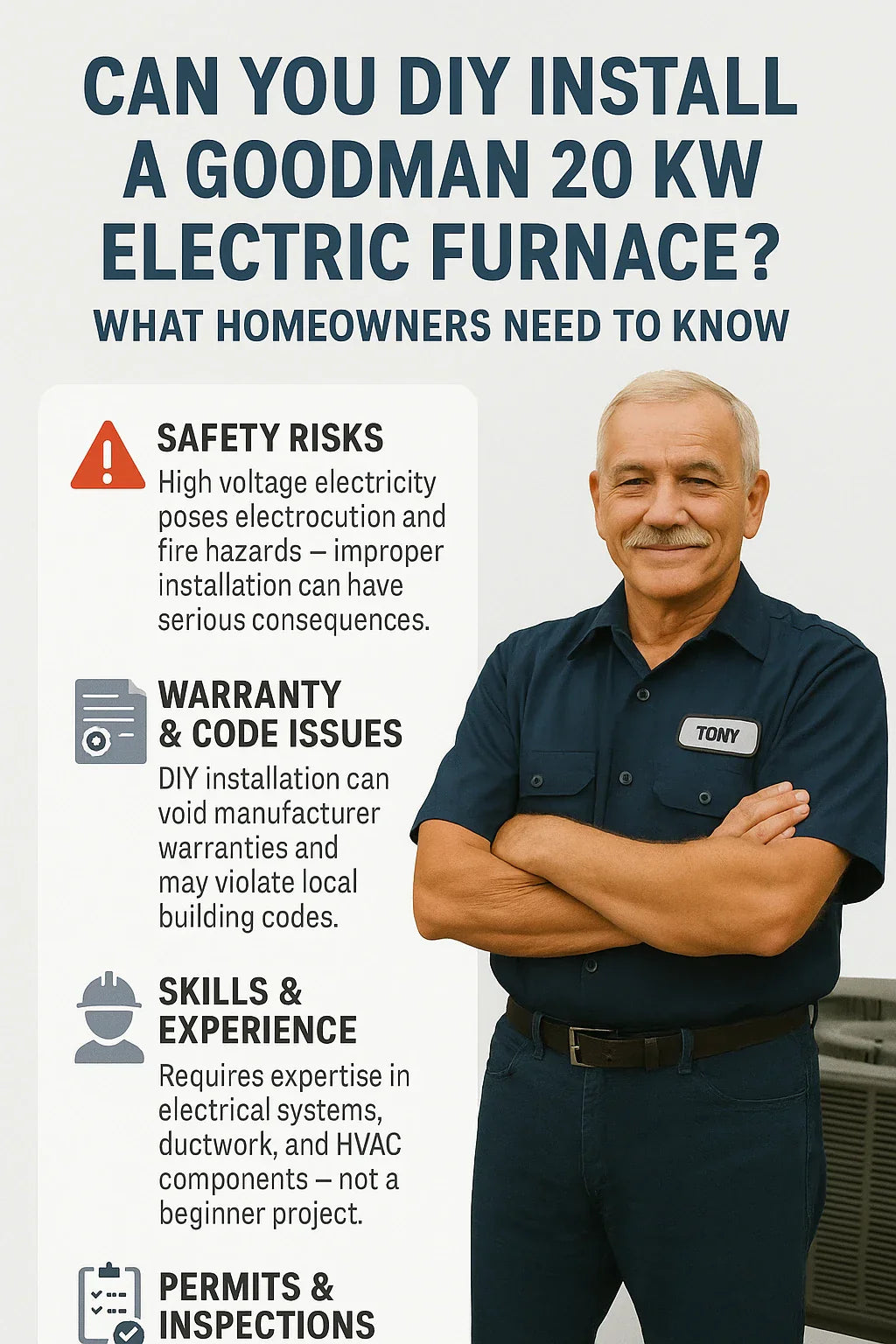DIY projects can save money and give homeowners a sense of accomplishment. But when it comes to installing a 20 kW electric furnace like the Goodman MBVK20DP1X00-HKTAD201, the stakes are much higher. In this detailed guide, Tony walks you through everything you need to know about the risks, realities, and legal requirements of a DIY electric furnace installation.
⚠ Short Answer: DIY Electric Furnace Installation Is Strongly Discouraged
While electric furnaces may seem simpler than gas systems (no fuel lines or venting), they still involve serious risks:
-
High-voltage electrical wiring
-
Massive power draw (80+ amps)
-
Strict building codes and inspections
-
Warranty and insurance implications
-
Fire and shock hazards
"I tell my customers all the time: there’s no YouTube video worth risking your family’s safety or your home’s insurance coverage," Tony says.
(Source: National Fire Protection Association (NFPA))
🔧 What Does an Electric Furnace Installation Involve?
| Task | DIY Challenge Level |
|---|---|
| Load Calculation (Manual J) | Advanced |
| Ductwork Modifications | Moderate |
| Heavy Electrical Wiring | High Risk |
| Panel Load Sizing | Advanced |
| Permits & Inspections | Legally Required |
| Final Testing & Safety Checks | Professional |
"It’s not that homeowners can’t physically move and position the furnace—it’s the power and code work that get people into serious trouble," Tony warns.
🔋 Electrical Panel Requirements for a 20 kW Furnace
The Goodman MBVK20DP1X00-HKTAD201 draws:
-
20,000 watts at 240 volts = ~83 amps
This often requires:
-
A dedicated 100-125 amp circuit breaker
-
4 AWG copper wiring (or larger depending on run distance)
-
Professional load calculations to ensure your existing panel can handle the additional load
"If your panel’s already maxed out, you’re looking at a full upgrade costing $1,500-$3,500 before you even start on the furnace itself," Tony explains.
(Source: NFPA Electrical Standards)
🧱 Building Code Requirements You Must Follow
-
State and local mechanical codes
-
Municipal permit requirements
-
Licensed inspection sign-off
Failure to comply can lead to:
-
Denied homeowner’s insurance claims
-
Fines from code enforcement
-
Risk of house fires
-
Resale complications
"No inspector is going to approve an unpermitted self-installed 20 kW furnace," Tony stresses.
(Source: Energy Star HVAC Contractor Checklist)
💰 How Much Could You Actually Save DIY?
| Item | Cost Savings Potential |
| Equipment Purchase | None (unit cost same either way) |
| Labor Install Fees | ~$1,000 - $2,000 |
| Permit/Inspection Fees | Required regardless |
| Electrical Work | Risky to DIY, often requires licensed electrician |
| Ductwork Adjustments | Possibly DIY-able |
Realistically, most of the potential labor savings come from minor ductwork adjustments, not electrical installation.
"Most of my customers save more money through rebates, financing, or energy savings than trying risky DIY installs," Tony says.
🧠 Warranties Require Professional Installation
Goodman’s factory warranty for MBVK series furnaces requires:
-
Licensed professional installation
-
Registration within 60 days
-
Proper permitting and inspection
| Warranty Term | With Pro Install | Without Pro Install |
| Parts Coverage | 10 Years | Often voided |
| Labor Coverage (optional) | Available | Denied |
(Source: Goodman Warranty Center)
"If you void your warranty by installing yourself, you could be on the hook for a $1,500 part replacement after just one failure," Tony explains.
🚑 Insurance & Liability Risks of DIY Installation
Home insurance policies may deny claims if:
-
Furnace installed without permit
-
Electrical work not performed by licensed professional
-
Fire originates from unapproved wiring
"If your house burns because of an unpermitted DIY furnace, your insurance adjuster will have a field day denying your claim," Tony warns.
(Source: Insurance Information Institute)
🧩 When Could DIY Involvement Make Sense?
Here’s where homeowners can safely contribute:
-
Removing old furnace (disconnect power first)
-
Minor duct sealing/insulation improvements
-
Installing new filter cabinets or return grilles
-
Installing smart thermostats (after wiring prepared by electrician)
-
Clean-up and finish carpentry work around unit
"Plenty of homeowners assist with prep and finish work to cut some labor hours. But they wisely leave the electrical guts to the licensed pros," Tony explains.
📑 Permit & Inspection Process for Legal Installations
1️⃣ Apply for mechanical and electrical permits
2️⃣ Schedule rough-in inspections (before power-up)
3️⃣ Schedule final inspections after installation
4️⃣ Receive signed-off approval for code compliance
"Permits aren’t just red tape—they protect you, your home value, and your insurance coverage," Tony advises.
🏷 Alternative Ways to Save Without DIY Risk
✅ Shop around for multiple licensed contractor quotes
✅ Check federal, state & utility rebate programs:
-
Federal tax credits for electric upgrades (Energy.gov Rebates)
-
State electrification rebates (DSIRE Database)
-
Utility energy-efficiency rebates
✅ Bundle with insulation upgrades for greater savings
✅ Finance through low-interest home improvement loans
🔧 Tony’s Honest Bottom Line
"Could you physically install a 20 kW electric furnace yourself? Probably. Should you? Absolutely not. Between high-voltage wiring, code compliance, insurance exposure, and warranty risks—it’s simply not worth it. My advice: focus your DIY energy on prep work and let licensed pros handle the parts that keep your house safe."
In the next article we will know about: Cold Climate Performance: How Well Does a Goodman 20 kW Electric Furnace Handle Winter?







